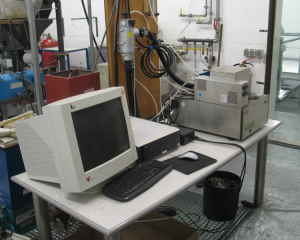FTIR
Extractive gas analysis with FTIR (Fourier Transformation Infrared Spectroscopy) “Nicolet Antaris IGS (industrial gas system), thermo scientific, 2008”
Fundamentals:
IR spectroscopy is a tested, often industrially used technology for the analysis of gaseous mixtures. The FTIR process is based on physical foundations of classic IR spectroscopy. It is simply an improved method of measuring and recording values with computer assistance.
IR spectroscopy is done in a wavelength range of 0.8 to 50 µm. Electromagnetic radiation has the energy content at these wavelengths that corresponds with the vibrational and rotational states of atoms in the molecular structure. This way, the covalent bonds in molecules can be excited. Because of the measurement principle, however, a number of limitations regarding the type of detectable components must be taken into account. In order for electromagnetic radiation with the corresponding frequency to be absorbed by a molecule, the vibration to be excited must lead to a change in the dipole moment of the molecule. Consequently, an excitation of diatomic, homoatomic molecules such as O2, H2 or N2, but also of monatomic noble gases, is not possible. These molecules cannot be directly captured using IR spectroscopy. Molecules that are made up of various types of atoms, however, absorb a part of the incidental radiation through excitation of the compounds at the wavelengths that are consistent with theirs. The resulting absorption spectrums are used for the identification of the compounds. Through calibration measurements preceding this process, the concentration of the compound in the gaseous mixture can also be determined.
Classic IR spectroscopy deals with particulate measurement methods, since the absorption behavior at the individual wavelengths is determined separately, and at different times. In FTIR spectroscopy, the entire irradiated spectrum regarding the absorption behavior can be analyzed in one measurement step. This is made possible through the Fourier transformation of the interfering measurement signal. Aside from the timely advantage, there is also an advantage in the exactitude of the calibration, the reachable solution, and the signal-noise relationship of the measurement.
The essential components of a FTIR spectroscope are a broadband emitting radiation source, an interferometer in which the interference of the measurement signal is produced, a gas cell with a sample, and a computer, which converts the irradiated interferogram into the absorptions spectrum through the Fourier transformation.
Radiation source:
The Globar made of silicon carbide provides IR radiation in the range of 2.5 µm to 25 µm, at an operating temperature of 1500K.
Interferometer:
Michelson Interferometer, made up of two separated optical threads, a measurement thread and a reference thread. The radiation splitter also assumes the function of the partially transparent mirror. The casing of the interferometer is flushed with nitrogen in order to increase the accuracy of the measurement.
Gas Cell:
The gas cell has an optical path length of 2 m. It is atmospherically operated, and heated from the outside to an operating temperature of 185 °C. The heat prevents the condensation of the components to be analyzed.
Detector:
An MCT-A (Mercury Cadmium Telluride) detector is used. This type of detector counts as a quantum detector. In the semiconductor material of the quantum detectors, charge carriers are excited by incidental photons, which creates an electric signal. In order to improve the sensitivity of the detector, the detector is cooled with liquid nitrogen.
Evaluation:
The FTIR is coupled with a user-friendly PC. The direction of the measurement value recording system, and the qualitative and quantitative analysis of the spectrums can be completed with the appropriate software modules on the computer. The calculated spectrum and the momentary concentration of the test can be shown online through a graphic user interface.
Calibration:
Currently, the device is calibrated for the quantitative analysis of the gases CO, CO2, H2O,CH4, SO2 and HCl. The device can, however, be expanded to all IR-active substances. In order for this to be possible, the appropriate calibration curves must be included.
